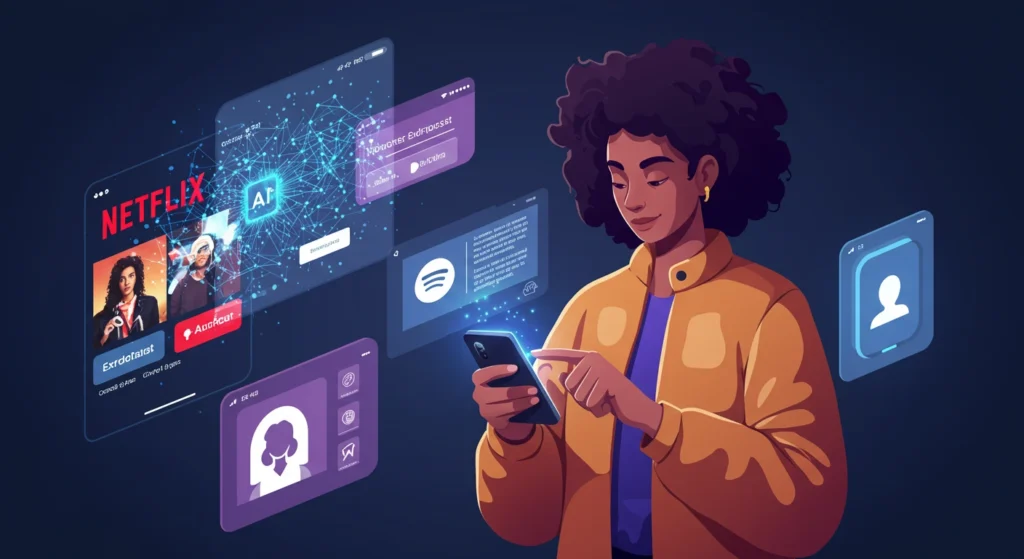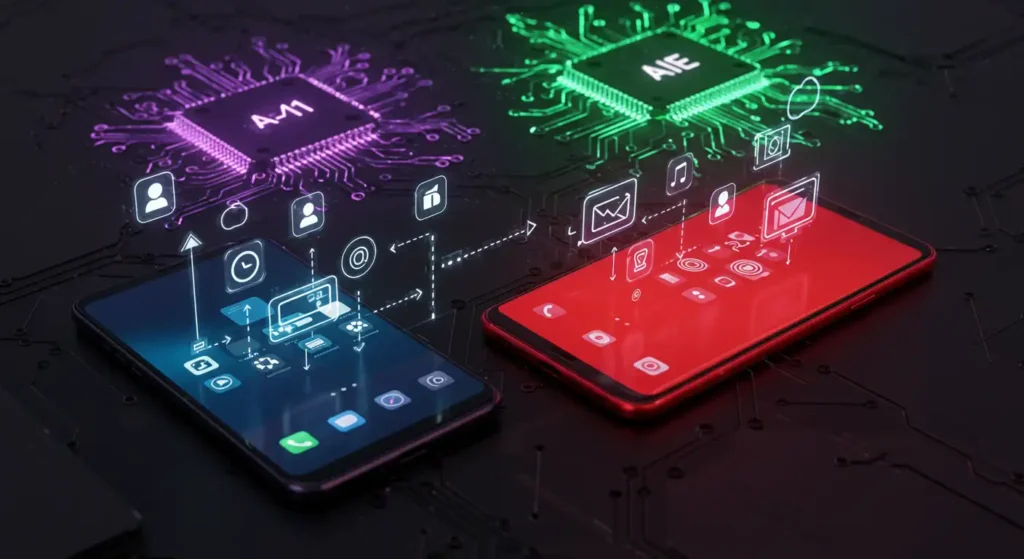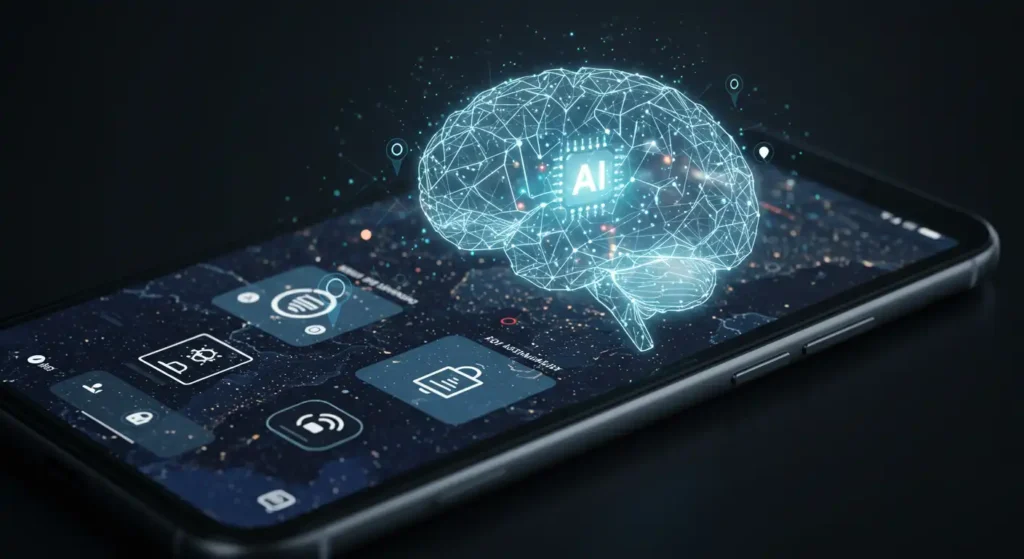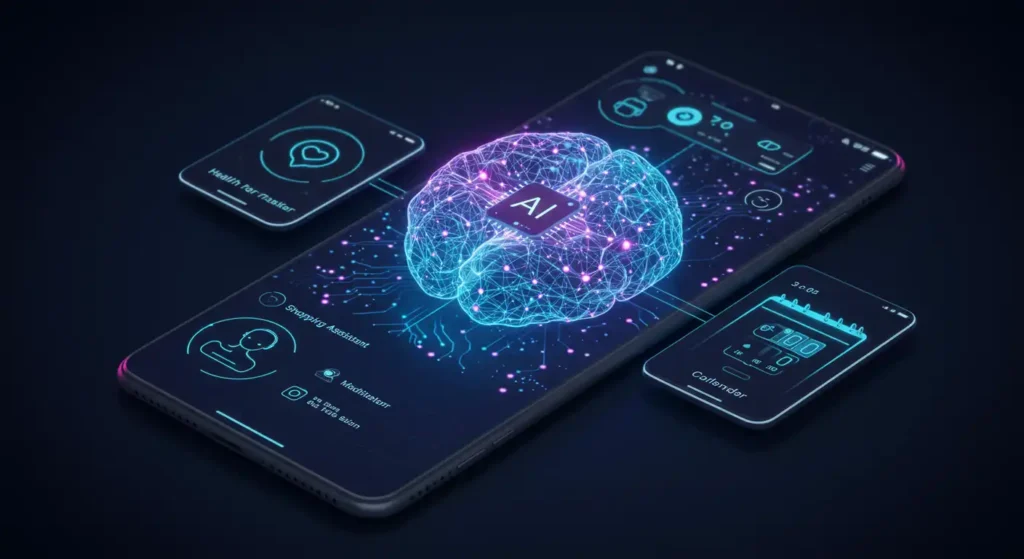The Invisible Power of AI in Mobile Apps
If you use mobile apps like Google Maps, Instagram, or even your phone’s camera, you’re already benefiting from artificial intelligence without even realizing it. To illustrate, from smart predictions to facial recognition and background optimization, artificial intelligence has quietly become the invisible engine that powers our digital lives. In this article, you’ll uncover how deeply artificial intelligence is integrated into mobile apps, transforming them into personalized, intelligent tools that make your daily tasks easier, faster, and smarter.
How Mobile Apps Use Artificial Intelligence for Smart Everyday Tasks

Personalized Recommendations and Smart Assistants
One of the most noticeable yet often overlooked uses of AI in mobile apps is personalized content. For instance, think of Netflix suggesting your next binge-worthy series or Spotify curating your daily mix. Specifically, behind these features are machine learning algorithms trained to analyze your behavior, preferences, and habits.
How It Works
For instance, mobile apps track user activity: what you watch, click, skip, like, or even hover over. Artificial intelligence uses this data to train recommendation engines. These systems constantly evolve, offering increasingly accurate suggestions tailored to your preferences.
Specifically, recommendation engines use collaborative filtering, content-based filtering, and hybrid approaches to ensure suggestions stay relevant. Over time, the algorithm learns your preferences more deeply sometimes even before you’re aware of them yourself.
Additionally, in smart assistants like Google Assistant, AI interprets voice, context, and even routines to trigger helpful reminders, actions, or responses. From setting alarms to controlling smart home devices, it feels like magic, but it’s intelligent data processing behind the scenes.
Real-World Example
According to TechCrunch, over 80% of the content watched on Netflix is driven by AI-powered recommendations. Likewise, this same type of tech is now present in countless apps, even your HP Smart App, which uses artificial intelligence to manage print queues, scan optimization, and error correction.
Smart Switch: Seamless Transfers and Setup via AI in Mobile Apps

Smarter Device Migration
Smart Switch is more than just a Samsung feature it represents a category of AI-powered mobile apps that make switching devices smooth and intuitive. As a result, by using predictive algorithms, these apps understand what content and preferences users value most and ensure they’re transferred without friction.
When users change phones or devices, smart switch technology steps in to reduce manual work. Artificial intelligence determines what data is essential and prioritizes its migration. Rather than copying everything, it focuses on:
- Frequently used apps
- Important contacts
- Personalized settings
- Custom wallpapers and layouts
Consequently, this makes the new device feel instantly familiar. AI even adjusts brightness settings and notification priorities based on your previous usage patterns.
What’s Happening Behind the Scenes
- Artificial intelligence detects app usage patterns over time.
- It prioritizes essential data (messages, contacts, Wi-Fi passwords).
- Recommends installation of most-used apps on the new device.
- Identifies potential compatibility issues ahead of time.
Some smart transfer apps now include anomaly detection to warn users about data conflicts, duplicate files, or app compatibility issues long before users encounter a problem.
Efficiency Boost
Apps like Samsung’s Smart Switch or Apple’s Quick Start use built-in AI to detect and restore app data efficiently. Furthermore, AI speeds up the process, ensures accuracy, and makes the entire transition stress-free.
Artificial intelligence in Mobile Apps You Don’t Expect: Hidden Tech in Plain Sight

Everyday Examples of Hidden AI
Not every AI-powered mobile app markets itself that way. Some, like Find My Phone or Microsoft Authenticator, use machine learning in subtle ways that significantly impact user experience.
Examples
- Microsoft Authenticator uses AI to analyze login patterns, reducing false positives in security alerts.
- Find My Phone relies on AI to predict and triangulate your phone’s last known location more accurately than GPS alone.
- Keyboard apps like SwiftKey or Gboard use AI to predict next words based on past typing history.
Many of these applications have background AI that users never see, but they provide smoother UX, stronger security, and time-saving automation.
Hidden Yet Essential
This hidden tech creates frictionless experiences that users come to expect. As artificial intelligence improves, these systems will become even more invisible and more powerful.
The Role of AI in Security, Location & Productivity for Mobile Apps

Find My Phone, Locate My Phone, and Smarter Location Tools
Locate my phone apps used to rely solely on GPS. Today, they integrate multiple data sources cell towers, Wi-Fi networks, user behavior to offer far more precise tracking. AI models help filter noise and enhance location accuracy even when GPS is off.
With geofencing and behavioral prediction, artificial intelligence estimates probable movement based on routine patterns. If your phone disappears at work, AI will check office Wi-Fi, commuting paths, and last app usage to pinpoint it better.
Microsoft Authenticator and Multi-Factor AI
Microsoft Authenticator now uses AI not only to secure logins but to detect abnormal behavior (e.g., sudden login from a new country) and initiate additional verification steps only when necessary.
Importantly, this balance between security and convenience is possible thanks to behavioral biometrics AI that recognizes how you interact with your phone: typing speed, finger pressure, motion gestures.
Boosting Mobile Productivity
Specifically, apps like HP Smart App or Google Assistant use voice recognition, text analysis, and image classification all powered by artificial intelligence to help users do more in less time.
Real-Time Features
- Scanning and enhancing documents
- Voice-command automation
- Smart task reminders based on email context
- AI-based photo editing with style transfer and subject detection
Mobile Apps with AI Everyday Use: The Future of Smart Apps

Evolution of User Interfaces
We’re moving from touch and type to talk and predict. Moreover, apps are increasingly using AI in everyday use to reduce friction and anticipate needs. Expect more apps to:
- Auto-summarize content
- Interpret voice commands
- Suggest time-saving shortcuts based on your schedule
- Track habits and offer suggestions proactively
Apps will become not just tools but active participants in your daily workflow. The goal? Minimize friction and maximize intention.
Artificial intelligence in Health, Fitness, and Shopping
For example, from tracking your heart rate to optimizing your grocery list, AI is optimizing the mobile apps you use every day. For example, apps like MyFitnessPal, Amazon, and Calm incorporate machine learning to help guide lifestyle changes, offer deals, and improve mental wellness.
Reference
A 2023 report by Statista shows over 90% of users interact with artificial intelligence features daily through their smartphones, often without awareness: (source)
Final Thoughts: Embrace the Invisible Genius
Whether you’re trying to find your phone, print a photo with HP Smart App, or secure your login with Microsoft Authenticator, ultimately, AI is quietly making everything smarter. In fact, these tools don’t just run in the background they run your digital life. By understanding how AI in mobile apps works, you can better harness its benefits and be more mindful of its presence.
⚡ Ready to Level Up Your Smart Life?
Don’t just use your apps understand them! Discover new AI-powered mobile apps and unlock hidden features to make your phone work smarter for you. 💡

